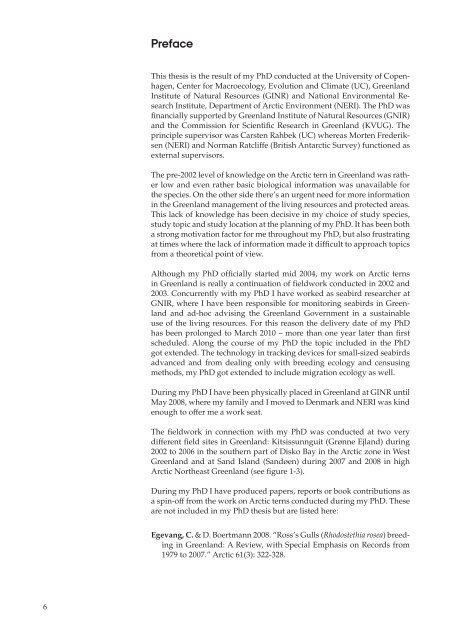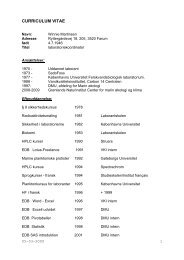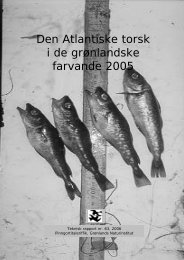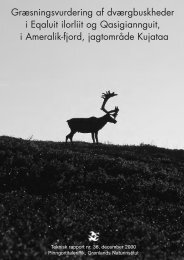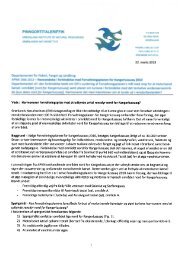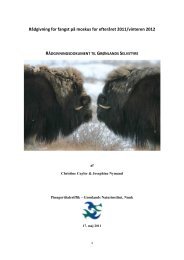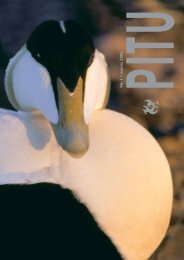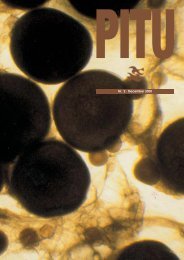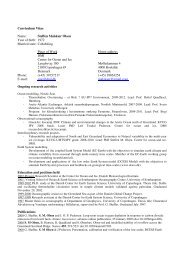Migration and breeding biology of Arctic terns in Greenland
Migration and breeding biology of Arctic terns in Greenland
Migration and breeding biology of Arctic terns in Greenland
You also want an ePaper? Increase the reach of your titles
YUMPU automatically turns print PDFs into web optimized ePapers that Google loves.
6<br />
Preface<br />
This thesis is the result <strong>of</strong> my PhD conducted at the University <strong>of</strong> Copenhagen,<br />
Center for Macroecology, Evolution <strong>and</strong> Climate (UC), Greenl<strong>and</strong><br />
Institute <strong>of</strong> Natural Resources (GINR) <strong>and</strong> National Environmental Research<br />
Institute, Department <strong>of</strong> <strong>Arctic</strong> Environment (NERI). The PhD was<br />
fi nancially supported by Greenl<strong>and</strong> Institute <strong>of</strong> Natural Resources (GNIR)<br />
<strong>and</strong> the Commission for Scientifi c Research <strong>in</strong> Greenl<strong>and</strong> (KVUG). The<br />
pr<strong>in</strong>ciple supervisor was Carsten Rahbek (UC) whereas Morten Frederiksen<br />
(NERI) <strong>and</strong> Norman Ratcliffe (British Antarctic Survey) functioned as<br />
external supervisors.<br />
The pre-2002 level <strong>of</strong> knowledge on the <strong>Arctic</strong> tern <strong>in</strong> Greenl<strong>and</strong> was rather<br />
low <strong>and</strong> even rather basic biological <strong>in</strong>formation was unavailable for<br />
the species. On the other side there’s an urgent need for more <strong>in</strong>formation<br />
<strong>in</strong> the Greenl<strong>and</strong> management <strong>of</strong> the liv<strong>in</strong>g resources <strong>and</strong> protected areas.<br />
This lack <strong>of</strong> knowledge has been decisive <strong>in</strong> my cho ice <strong>of</strong> study species,<br />
study topic <strong>and</strong> study location at the plann<strong>in</strong>g <strong>of</strong> my PhD. It has been both<br />
a strong motivation factor for me throughout my PhD, but also frustrat<strong>in</strong>g<br />
at times where the lack <strong>of</strong> <strong>in</strong>formation made it diffi cult to approach topics<br />
from a theoretical po<strong>in</strong>t <strong>of</strong> view.<br />
Although my PhD <strong>of</strong>fi cially started mid 2004, my work on <strong>Arctic</strong> <strong>terns</strong><br />
<strong>in</strong> Greenl<strong>and</strong> is really a cont<strong>in</strong>uation <strong>of</strong> fi eldwork conducted <strong>in</strong> 2002 <strong>and</strong><br />
2003. Concurrently with my PhD I have worked as seabird researcher at<br />
GNIR, where I have been responsible for monitor<strong>in</strong>g seabirds <strong>in</strong> Greenl<strong>and</strong><br />
<strong>and</strong> ad-hoc advis<strong>in</strong>g the Greenl<strong>and</strong> Government <strong>in</strong> a susta<strong>in</strong>able<br />
use <strong>of</strong> the liv<strong>in</strong>g resources. For this reason the delivery date <strong>of</strong> my PhD<br />
has been prolonged to March 2010 – more than one year later than fi rst<br />
scheduled. Along the course <strong>of</strong> my PhD the topic <strong>in</strong>cluded <strong>in</strong> the PhD<br />
got extended. The technology <strong>in</strong> track<strong>in</strong>g devices for small-sized seabirds<br />
advanced <strong>and</strong> from deal<strong>in</strong>g only with <strong>breed<strong>in</strong>g</strong> ecology <strong>and</strong> census<strong>in</strong>g<br />
methods, my PhD got extended to <strong>in</strong>clude migration ecology as well.<br />
Dur<strong>in</strong>g my PhD I have been physically placed <strong>in</strong> Greenl<strong>and</strong> at GINR until<br />
May 2008, where my family <strong>and</strong> I moved to Denmark <strong>and</strong> NERI was k<strong>in</strong>d<br />
enough to <strong>of</strong>fer me a work seat.<br />
The fi eldwork <strong>in</strong> connection with my PhD was conducted at two very<br />
different fi eld sites <strong>in</strong> Greenl<strong>and</strong>: Kitsissunnguit (Grønne Ejl<strong>and</strong>) dur<strong>in</strong>g<br />
2002 to 2006 <strong>in</strong> the southern part <strong>of</strong> Disko Bay <strong>in</strong> the <strong>Arctic</strong> zone <strong>in</strong> West<br />
Greenl<strong>and</strong> <strong>and</strong> at S<strong>and</strong> Isl<strong>and</strong> (S<strong>and</strong>øen) dur<strong>in</strong>g 2007 <strong>and</strong> 2008 <strong>in</strong> high<br />
<strong>Arctic</strong> Northeast Greenl<strong>and</strong> (see fi gure 1-3).<br />
Dur<strong>in</strong>g my PhD I have produced papers, reports or book contributions as<br />
a sp<strong>in</strong>-<strong>of</strong>f from the work on <strong>Arctic</strong> <strong>terns</strong> conducted dur<strong>in</strong>g my PhD. These<br />
are not <strong>in</strong>cluded <strong>in</strong> my PhD thesis but are listed here:<br />
Egevang, C. & D. Boertmann 2008. “Ross’s Gulls (Rhodostethia rosea) <strong>breed<strong>in</strong>g</strong><br />
<strong>in</strong> Greenl<strong>and</strong>: A Review, with Special Emphasis on Records from<br />
1979 to 2007.” <strong>Arctic</strong> 61(3): 322-328.


